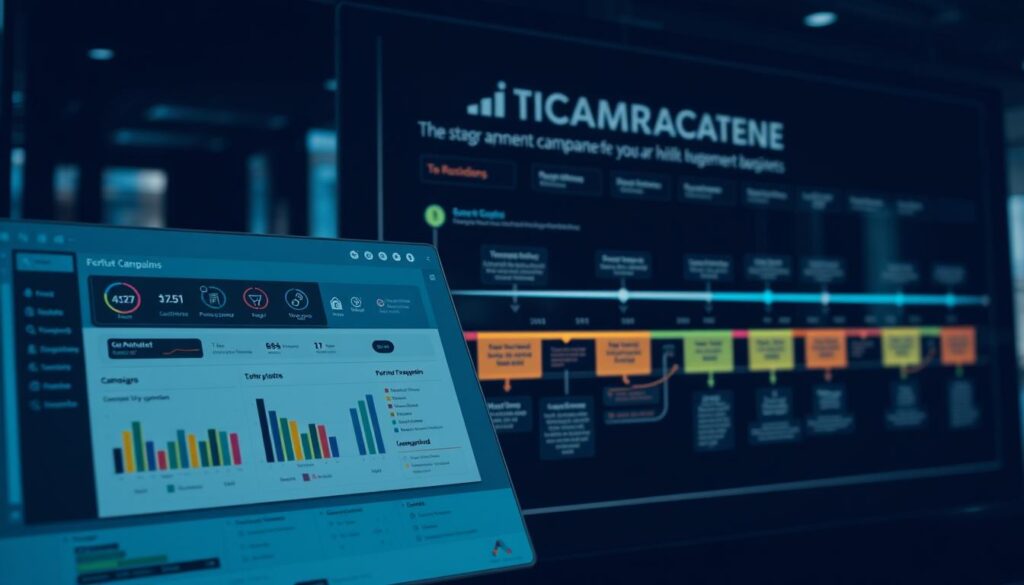Launching a new offering requires more than just creativity—it demands precision. A well-designed strategy bridges the gap between product development and customer adoption, ensuring every team works toward shared objectives. By aligning pricing, messaging, and distribution, businesses minimize wasted resources while maximizing impact.
Today’s competitive landscape leaves little room for guesswork. Companies must identify their ideal buyers early, craft compelling value propositions, and select channels that deliver measurable results. This approach transforms isolated efforts into cohesive systems, reducing launch timelines by up to 40% according to industry benchmarks.
Data-driven decision-making separates thriving organizations from those struggling to gain traction. Analyzing market trends and competitor moves allows teams to refine positioning in real time. When sales, customer success, and product teams share insights, they create feedback loops that accelerate growth.
Key Takeaways
- Align cross-functional teams to unify product launches and scaling efforts
- Prioritize customer intelligence to shape pricing and promotional tactics
- Optimize distribution models based on target audience behavior
- Leverage competitive analysis to refine messaging strategies
- Establish metrics to track campaign performance and ROI
Defining a Successful Go-to-Market Strategy
Success in new markets begins with a cohesive blueprint that unites product, messaging, and delivery. This blueprint—often called a gtm strategy—acts as a roadmap for converting business objectives into measurable outcomes. It transforms abstract ideas into actionable steps, ensuring every decision aligns with core goals.
Key Elements and Benefits
Every effective market strategy rests on five pillars. First, clearly defined geographic or demographic targets prevent resource waste. Second, deep customer insights enable personalized engagement through preferred channels. Third, distribution models must balance reach with cost efficiency—direct sales for premium products, digital platforms for mass markets.
Fourth, messaging must articulate unique value without jargon. A SaaS company might emphasize time savings rather than technical specs. Finally, pricing structures should reflect both competition and long-term profitability goals.
Organizations using this framework see 35% faster launches and 22% higher customer retention. Clear direction reduces internal friction while creating adaptable growth paths.
Aligning Business Functions
Product teams need real-time sales feedback to prioritize features. Marketing must translate technical capabilities into emotional benefits. When these groups share data weekly, they spot trends faster—like shifting buyer priorities during economic downturns.
This synchronization turns departmental outputs into interconnected gears. One fintech firm increased deal closures by 18% after implementing joint planning sessions between engineering and account managers.
Targeting Your Ideal Customer Profile
B2B purchasing decisions rarely hinge on a single individual. Gartner research reveals six to ten stakeholders typically shape complex deals, each with distinct priorities. Mapping this ideal customer profile requires analyzing firmographics, decision hierarchies, and hidden pressures influencing buying committees.

Identifying Buyer Personas
Effective targeting moves beyond job titles to uncover motivations. A CFO might prioritize cost savings, while IT managers focus on integration ease. Understanding your target audience involves mapping:
- Professional goals and KPIs driving each role
- Preferred communication styles (data-driven vs. narrative)
- Influence levels across procurement stages
Understanding Customer Pain Points
Surface-level challenges like budget constraints only tell part of the story. Deeper pain points often involve unspoken fears—such as job security risks from failed implementations. Successful teams combine surveys, win/loss interviews, and competitor analysis to identify:
- Process inefficiencies draining productivity
- Compliance gaps creating legal exposure
- Missed revenue opportunities from outdated systems
This approach helps craft solutions addressing both stated needs and underlying anxieties, increasing conversion likelihood by 27% according to CSO Insights.
Creating a Compelling Value Proposition
Differentiation in crowded industries starts with a razor-sharp value proposition. This critical statement defines how your product solves specific problems better than alternatives. Achieving product-market fit means aligning features with genuine needs—not just what buyers say they want, but what drives measurable outcomes.
| Component | Role | Example Metric |
|---|---|---|
| Customer Pain Points | Identifies urgent needs | 83% faster issue resolution |
| Competitive Gaps | Highlights unique advantages | 40% lower operational costs |
| Measurable Outcomes | Quantifies value delivery | 28% revenue growth in 6 months |
B2B buyers prioritize solutions addressing both functional needs and emotional drivers. A cybersecurity company might emphasize risk reduction (rational) while also appealing to decision-makers’ career security (emotional).
Testing different messaging variants across customers reveals what resonates. One SaaS firm increased conversions by 19% by emphasizing time savings over technical specs in their marketing.
Regularly reassess your proposition as market conditions shift. Quarterly reviews of competitor moves and buyer feedback keep your strategy aligned with evolving demands.
Crafting Effective Messaging and Positioning
Sharp messaging cuts through market noise by speaking directly to buyer priorities. Teams must connect product capabilities to specific outcomes using language that resonates with decision-makers’ daily realities. This requires systematic alignment between audience insights and communication strategies.
Developing Tailored Messages
A value matrix aligns product strengths with audience needs. Start by matching each persona’s challenges to your solution’s unique advantages. For example, highlight cost savings for finance leaders and efficiency gains for operations teams.
Effective content addresses both logical needs and emotional drivers. Technical buyers might need data sheets, while executives prefer high-level ROI summaries. This dual approach increases relevance across stakeholder groups.
| Message Element | Top Channels | Performance Metric |
|---|---|---|
| Problem-Solution Framing | LinkedIn Articles | 17% higher engagement |
| ROI Calculators | Email Campaigns | 23% conversion lift |
| Case Studies | Webinars | 31% lead quality improvement |
Testing Messaging Across Channels
Different marketing channels demand unique approaches. Professional networks like LinkedIn favor data-driven insights, while social media platforms thrive on concise, shareable narratives. Always adapt tone without diluting core propositions.
A/B testing reveals what works. Try two message variants simultaneously across Google Ads and Twitter. Track which version drives more qualified leads. One SaaS company boosted sign-ups by 14% using this method.
Regularly update content based on performance data. Monthly reviews of click-through rates and conversion paths help refine approaches. Consistent testing ensures messages stay aligned with shifting target preferences.
Establishing Distribution Channels and Sales Funnel
Choosing the right pathways to reach buyers separates thriving businesses from those stuck in stagnation. Effective distribution channels act as bridges connecting products to customers, while optimized sales funnels guide prospects from discovery to purchase. This dual focus ensures resources flow where they create maximum impact.
Four primary models dominate modern market approaches. Self-service platforms work best for straightforward solutions needing minimal guidance—think SaaS tools with intuitive interfaces. Inside sales teams excel when nurturing leads through educational content and personalized demos becomes essential.
Field sales strategies shine in enterprise environments where complex deals demand tailored solutions. Channel partnerships accelerate expansion into new regions without heavy infrastructure investments. Each model requires distinct strategy adjustments based on product complexity and buyer expectations.
Multi-channel approaches often deliver superior results. A cybersecurity firm might combine self-service portals for SMBs with field reps for Fortune 500 accounts. This flexibility maintains brand consistency while addressing diverse customer needs across segments.
Optimizing the sales funnel involves tracking progression patterns. Analyze where prospects stall—are awareness-stage videos underperforming? Do consideration-phase emails need stronger CTAs? Regular funnel audits reveal leaks before they drain revenue potential.
Successful organizations align channel choices with funnel stages. Digital ads might fuel top-funnel awareness, while account-based marketing nurtures middle-funnel leads. This strategic harmony reduces wasted effort and accelerates deal velocity.
Mastering go to market campaign management
Superior campaign execution transforms theoretical strategies into measurable outcomes. It demands alignment between buyer journey insights and organizational capabilities, ensuring every phase—from awareness to renewal—flows seamlessly across teams.

Planning and Execution Strategies
Effective gtm strategy development starts with mapping dual perspectives. Marketing teams analyze attraction channels, while sales focuses on decision-stage triggers. This alignment prevents friction during handoffs and accelerates deal velocity.
| Strategy Component | Department | Key Metric |
|---|---|---|
| Lead Nurturing | Marketing | 45% faster pipeline movement |
| Deal Qualification | Sales | 32% higher win rates |
| Renewal Forecasting | Customer Success | 27% reduced churn |
Cross-functional workshops identify gaps in messaging or resource allocation. One enterprise software provider reduced implementation delays by 41% through joint planning sessions between product and support teams.
Optimization Techniques
Continuous improvement relies on three pillars:
- Real-time sales funnel analytics to detect bottlenecks
- A/B testing of nurture sequences across email and social
- Quarterly strategy reviews using customer feedback
“The best plans adapt faster than markets change.”
Agile adjustments maintain relevance amidst shifting priorities. Tracking both leading indicators (website engagement) and lagging metrics (LTV) creates a complete performance picture. Teams that implement this dual-lens approach see 19% higher ROI on campaign spend.
Leveraging Cross-Functional Teams for GTM Success
Building high-performing team structures unlocks GTM potential through coordinated expertise. Representatives from product development, marketing sales alignment, and customer success form the core. Adding pricing specialists ensures financial viability, while a dedicated GTM manager maintains strategic focus across departments.
Defining Roles and Responsibilities
Clear role definitions prevent overlap and accelerate decision-making. Product teams validate feature priorities, while sales teams translate technical capabilities into client benefits. Customer success provides implementation insights that shape future strategy adjustments.
Effective collaboration requires documented responsibility matrices. These tools specify who approves budgets, handles escalations, and shares cross-departmental knowledge. Teams using this approach reduce launch delays by 37% according to TechRepublic research.
Performance metrics must align individual goals with collective outcomes. Shared KPIs for pipeline growth and customer retention foster unity. Regular sync meetings maintain momentum, ensuring all voices contribute to gtm strategy refinement.
When teams operate as interconnected systems rather than silos, they transform ambitious plans into executed results. This synergy turns complex launches into repeatable processes that drive sustainable growth.
FAQ
What separates successful product launches from failed ones?
Successful launches combine precise ideal customer profiling with data-driven market strategies. Companies like HubSpot attribute their growth to aligning sales teams with customer pain points early, optimizing acquisition costs through continuous funnel adjustments.
How do companies identify their true target audience?
Leading brands use behavioral analytics and demographic segmentation. Salesforce’s approach involves mapping customer journeys across marketing channels before finalizing buyer personas. This reveals hidden patterns in how decision-makers engage with content.
Why do 42% of startups struggle with customer acquisition costs?
Many overlook sales cycle length when planning budgets. Slack’s freemium model succeeded by testing free trials against paid tiers, proving that balancing value propositions with pricing models directly impacts sustainable growth.
Can established brands apply GTM strategies for new markets?
Adobe’s shift to cloud subscriptions shows legacy companies can reinvent distribution channels. The key lies in retraining sales teams to address unfamiliar pain points while leveraging existing customer relationships.
What metrics matter most in campaign optimization?
Conversion rates at each funnel stage and customer lifetime value outweigh vanity metrics. Shopify’s dashboard prioritizes repeat purchase rates and cart abandonment data, enabling real-time adjustments to messaging and offers.
How crucial are cross-functional teams in execution?
Microsoft’s Surface launch proved alignment between product, marketing, and support teams accelerates time-to-market. Clear role definitions prevent duplicated efforts while maintaining consistent brand messaging across touchpoints.



